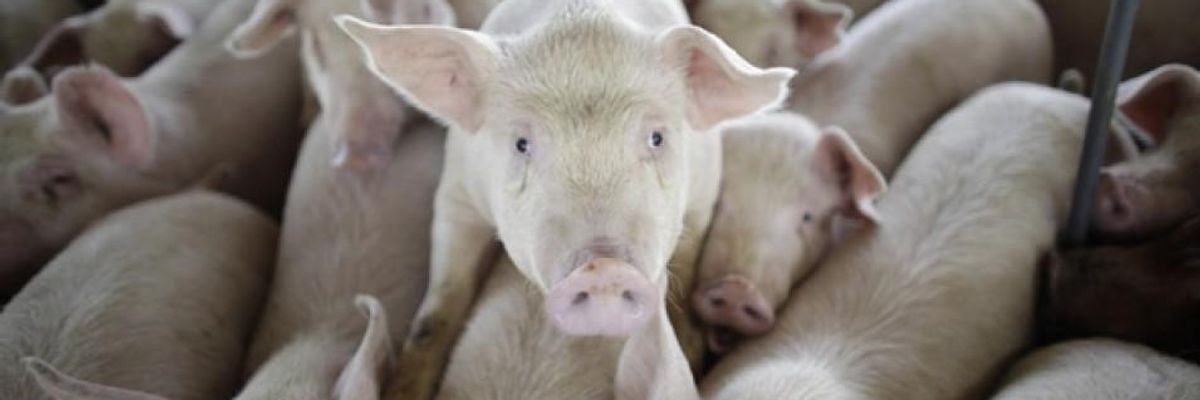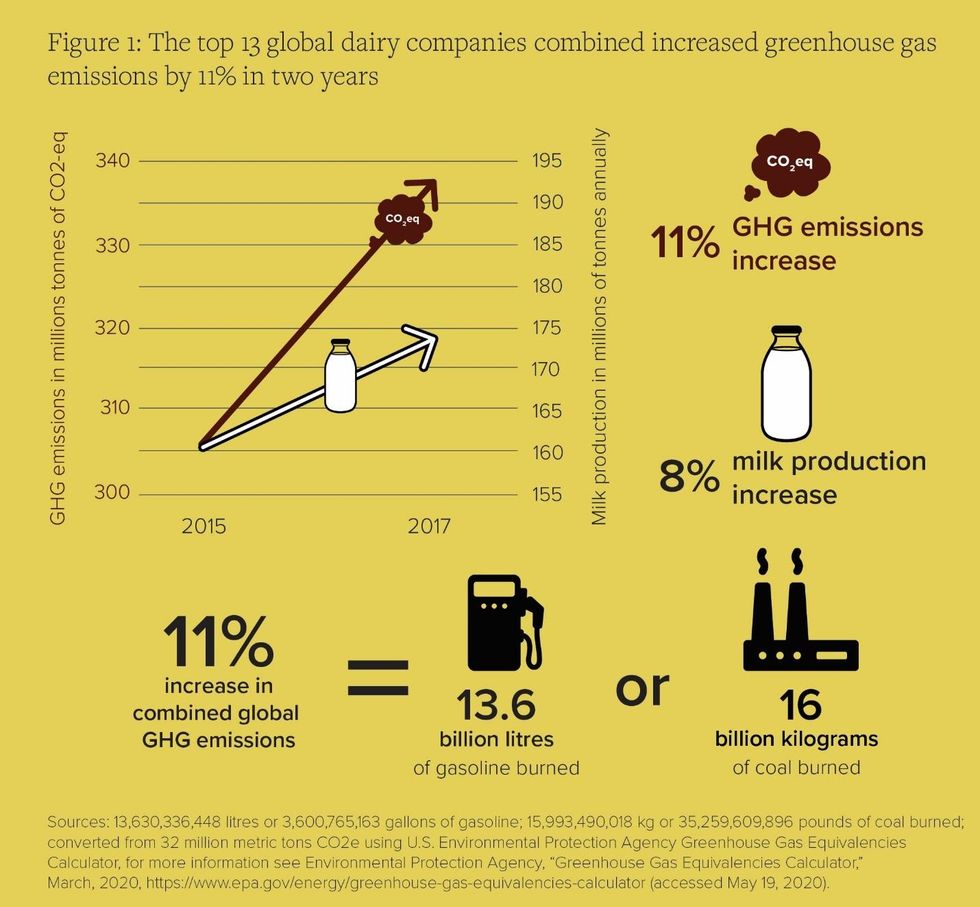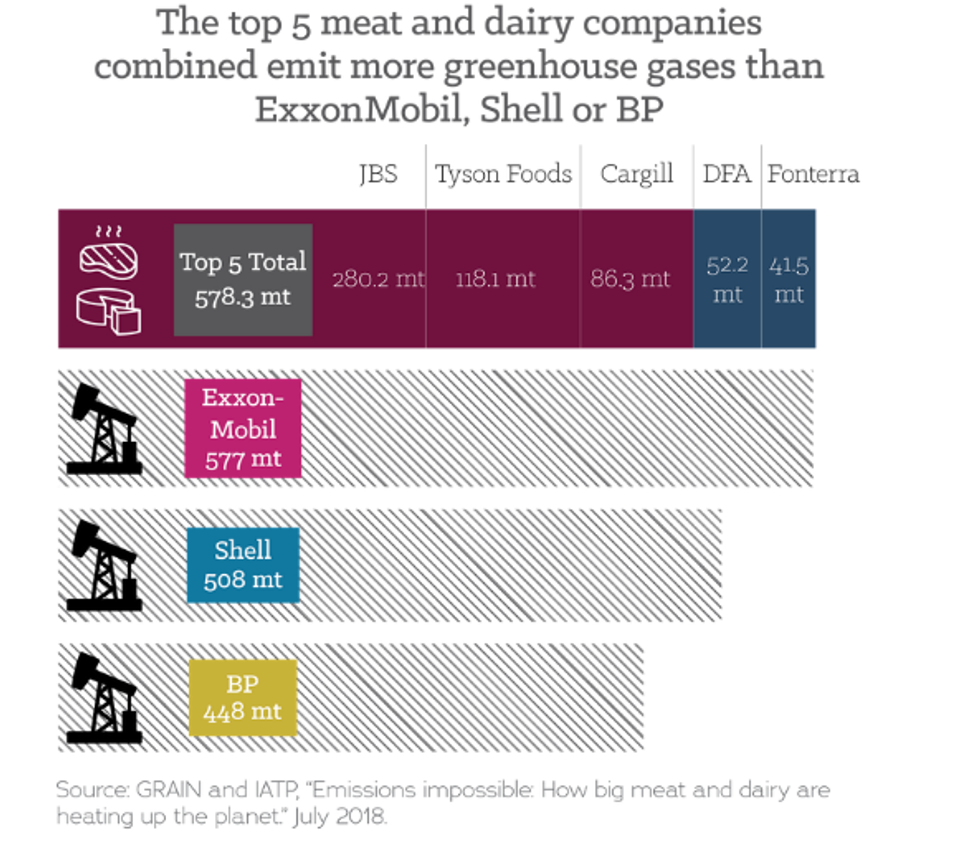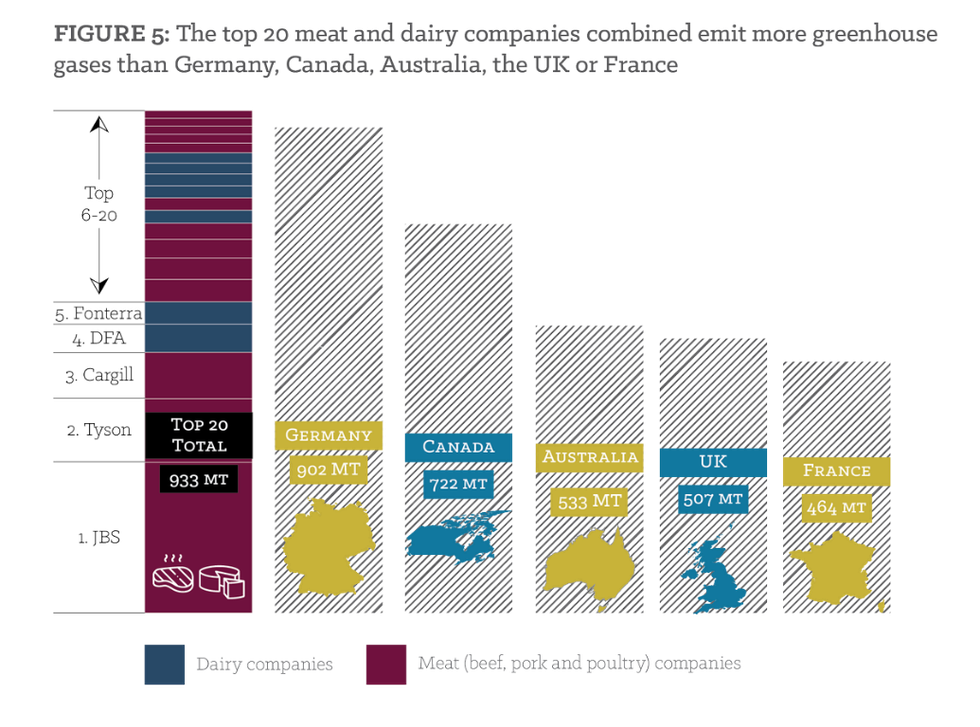The following article was published originally as part of the Climate Land Ambition & Rights Alliance (CLARA)'s Net Zero Files.
In March 2021, the biggest meat company in the world, JBS, made an astonishing announcement. The company, embroiled in major bribery and corruption scandals just a few years ago, pledged it would reach net zero greenhouse gas emissions by 2040. A 2018 report by the Institute for Agriculture and Trade Policy and GRAIN had found the company was the largest GHG emitting livestock company in the world, responsible in 2016 for an estimated 280 million tonnes CO2 equivalent. By comparison, Malaysia and Spain's 2019 emissions were 250 and 253 million tonnes CO2e, respectively. The JBS announcement included no plans to reduce meat production. So, how can it possibly achieve its 2040 net zero target?
"None of the net zero commitments made by major meat and dairy companies call for reducing the number of animals in their supply chains."
As global meat and dairy companies have come under increasing scrutiny for their contributions to the climate crisis, net zero accounting has been a corporate lifesaver. Meat and dairy giants such as JBS, Tyson, Danish Crown, Nestle, Danone, Arla and Fonterra have all announced net-zero targets. Yet, in our examining of company documents, reports and projections, none of the major meat and dairy companies planned on reducing the number of animals in their supply chain, the source of 90% of their emissions. On the contrary, most have plans to significantly expand production and market share. For example, Tyson expects annual growth of 3-4 percent from beef and poultry sales, while Marfrig targeted 7.5-9.5 percent annual growth for 2015-2018. This target was set prior to the company's acquisition of U.S.--based National Beef, making it the second largest beef processor in the world. Danish dairy giant Arla planned to add 2 billion kg of milk to its European supply chain between 2015-2020--a 14 percent increase. Fonterra projected a stunning 40 percent increase in its processed milk volume for 2015-2025.
Net Zero Masks Growing Emissions
How do these companies claim emission reductions, yet project to continue expanding production? The net zero framework is the escape hatch to do just that.
For example, parts of JBS' remarkable commitment include reducing emissions in their facilities and using more renewable energy. The company also pledges to eliminate illegal deforestation throughout its supply chain by 2025, stop all deforestation in the Amazon region by 2030) and achieve zero deforestation across its global supply chain by 2035. It has made such commitments before. In 2009, the company promised to eliminate deforestation in its supply chain by 2011. Greenpeace noted that JBS' new pledge, "couldn't make it more clear: JBS will continue to fuel deforestation in the Amazon and beyond for at least another 14 years, and fuel the climate crisis well after that."
JBS has a checkered past of making various environmental-related pledges and then reneging on those commitments. JBS was given a score of 1 out of 100 on the Soy and Cattle Deforestation Tracker developed by the environmental organization Mighty Earth. Our estimates of their 2016 emissions were 3000% higher than their reported emissions. The company has been repeatedly accused of sourcing beef from farmers linked with illegal deforestation in the Amazon. Several academic studies have documented how cattle is leaked and laundered in JBS's supply chain from deforestation zones into slaughterhouses that are deemed "clean".
To reach its 2040 target, JBS states it will spend $1 billion on unnamed emissions reduction projects and another "$100 million by 2030 in research and development projects to assist producer efforts to strengthen and scale regenerative farming practices, including carbon sequestration and on-farm emission mitigation technologies. This investment will contribute to reducing scope 3 emissions across the value chain, in our efforts toward net zero." JBS does not say how much of the company's 2040 net zero pledge will come from carbon sequestration or these unnamed emissions reductions projects.
The world's biggest pork producers, WH Group and its subsidiary Smithfield, have put their twist on net zero as well, claiming that they will go carbon negative by 2030. That pledge applies only in the U.S. and doesn't consider the Group's considerable global climate footprint. WH Group's Chinese operations generated 43 percent of its profits in 2017. In addition, Smithfield's reporting excludes emissions from large operations in Mexico, as well as production facilities in Poland and Romania. Under the pledge, Smithfield will utilize renewable energy and fuels, and will employ regenerative agriculture practices that will sequester carbon. The company does not say how much carbon it plans to sequester. Much of the 2030 pledge relies on the company's effort to convert its considerable pig manure into methane gas to produce energy or flow into natural gas pipelines. The company counts this gas produced from its factory farms as renewable and as an emissions reduction, in spite of widespread ecological and public health problems the manure causes. While the company profits off of waste, communities surrounding Smithfield's operations in the U.S. have highly criticized this form of factory farm gas.
Danone, the world's second largest dairy company in terms of revenue, also uses net zero accounting to boost its climate commitment. It is one of the more transparent companies in terms of emissions reporting and a commitment to invest in its supply chain for emissions reductions. Danone has committed to "zero net emissions" by 2050 (a target consistent with the one laid out in the Paris climate agreement). These reductions extend to its reported supply chain emissions from dairy. However, Danone also plans to increase production. In fact, Danone's emissions increased by 15% between 2015-2017. Part of Danone's plan is to counterbalance its dramatic increase in output with an extraordinary (and perhaps technically unfeasible) reduction in emissions intensity (i.e., emissions per kilogram of milk) by its dairy farmer suppliers and carbon offsets through a "Livelihoods Carbon Fund" that proposes to sequester carbon in the Global South with sustainable agriculture practices. The company's 2030 commitment requires farmer suppliers to achieve extremely aggressive intensity-reduction targets--more than 30 percent in most cases--while making the shift to more sustainable practices.
Fonterra seeks an even more aggressive rate of growth, and unlike Danone its net zero commitment is confined to just manufacturing plants--not supply chain reductions. It seeks to reengineer its cow herds, rather than reduce them, by working to eliminate methane from cow guts through the use of seaweed or new fermentations called "Kowbuchas." Other companies make similar projections about per-animal emission reductions based on a variety of experimental biotech feeds and supplements.
Emissions Intensity--Sleight of Hand.
The meat and dairy industry frequently utilize a measure--emissions intensity targets--that distracts from the company's overall emissions. Such targets count emissions per kilogram of meat or milk, but they do nothing to curtail overall growth in company emissions or processing volumes. Emissions intensity reduction in the supply chain comes from further industrial-style intensification and scaling, pumping out more milk or meat per animal and/or using less feed per animal. Such pledges allow for greenwashing because companies can highlight emissions reductions per litre of milk even if their total emissions continue to rise. This is clearly demonstrated by the Global Dairy Platform, an association of some of the largest global dairy corporations.
The Dairy Platform's joint study with the FAO reports that the industry reduced emission intensity by 11% between 2005-2015; however, its overall emissions increased by 18% in that same period. This is because these companies dramatically increased their worldwide operations and the number of animals in their supply chains, even as they reduced emissions per litre of milk processed.
An emissions intensity approach also provides a justification for exports. If New Zealand or the EU is a lower-intensity producer of milk than African countries, the reasoning goes, then the climate will benefit by having sub-Saharan African nations import from higher-efficiency countries rather than produce their own milk. This argument could be used to claim that trade barriers or national emission-reduction schemes unfairly penalise European or New Zealand dairy producers. The reality is that it makes African countries the 'dumping' ground for major dairy exporting nations and regions including companies based in New Zealand, the U.S. and the EU, causing disruption and dislocation of small scale producers in African countries, impacting both livelihoods and food sovereignty.

How Big are the Emissions from Meat and Dairy Companies?
Allowing global meat and dairy companies to continue business as usual, with a never-ending growth model, would be a disaster for the climate. The IPCC's latest state of the science report makes it clear that methane emissions reductions this decade could buy humanity time to limit warming to 1.5 C. The Livestock sector contributes to 32% of these emissions. IATP recently reported that in 2017, the combined emissions of the world's thirteen largest dairy corporations emitted more GHGs than major polluters like BHP, the Australia-based mining giant, or ConocoPhillips, the United States-based oil company. Even as governments signed the Paris Agreement in 2015 to significantly rein in global emissions, these big dairy companies' increase of 32.3 million tonnes (MtCO2eq) of GHGs equates to the pollution stemming from 6.9 million passenger cars driven in one year (13.6 billion litres or 3.6 billion gallons of gasoline). Some dairy companies increased their emissions by as much as 30% in the two-year period.
Our 2018 report, Emissions Impossible, found that the top five biggest meat and dairy companies in the world combined to emit more than Exxon/Mobil, Shell or BP. The top 20 companies combined emitted more than many countries, like Germany, Canada and the UK.

Unlike their counterparts in the energy sector, the lack of public scrutiny on the magnitude of the GHG footprints of big meat and dairy companies has slowed climate action. Thus far, very few companies report or set targets on their emissions. Those that do so, pick and choose a variety of metrics and projections that make it difficult to hold them accountable. Most also seriously underreport emissions or do not include the bulk of their supply chain emissions in their calculations.

Getting to Actual Emissions Reductions
Industrial large-scale animal agriculture is by far the largest component of overall land-sector emissions. But net zero accounting, and its endorsement of the use of land-based offsets to meet climate commitments, is slowing down a much-needed transition in meat and dairy production systems. Governments must mandate human rights and equity-based absolute emissions reduction from the corporate livestock sector and support a just transition for producers and workers in the shift to agroecological food systems.




